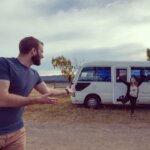The flooring for your bus conversion is not a hard job, however deciding on what you want to use can be.
There are many flooring options available, so we have compiled a list of available choices for you to compare. After this, we discuss the flooring option we chose, why we chose it, and how to install.
Flooring Options –
| Pros | Cons | |
| Carpet | Cost Availability (so many options!) Easy installation Soft/warm underfoot | Hotter during Summer More clean-up/vacuuming required Higher maintenance |
| Vinyl Sheeting | Cost Waterproof Lightweight Easy installation Easy maintenance Availability/product range Thin | Must be installed directly on the sub-floor; cannot have underlay or insulation underneath Doesn’t look ‘real’ |
| Vinyl Planks | Cost Most varieties waterproof Lightweight Easy installation Easy maintenance Hardwearing and durable ‘Real’ wood look without the cost Thin Self-adhesive | Possible heat shrink over time Must be installed directly on the sub-floor; cannot have underlay or insulation underneath |
| Laminate | Cost Water resistant Hardwearing Availability/product range Easy installation | Thicker than vinyl planks May not look ‘real’ |
| Tiles | Physically attractive Easy maintenance | Cost Weight Harder installation Longer installation Fragile |
| Hardwood Flooring | Looks amazing! Relatively easy maintenance | Cost! Weight Installation harder and longer |
| No Flooring | Cost Easiest option available Can just cover with mats/carpet/desired flooring No installation required | May not be as physically nice as other options Unable to check sub-floor status Unable to lay underlay/insulation |
What flooring did we choose for our bus conversion?
Self adhesive vinyl planks from Bunnings.
Why? Cost, availability, look, ease, reviews!
A lot of people warned us against the vinyl planks, and said we will need to be careful; “They lift, they shrink, they don’t last!”. Gerflor even recommend not using the 2mm Senso Rustic product line in a caravan or motorhome for that reason. We of course learnt this after purchasing our floor boards.
However after speaking to a lovely lady at Choices flooring, she suggested we get around this by using a vinyl adhesive, and not just relying on the adhesive on the planks themselves.
The floor boards were cheap enough to risk giving it a go, so that’s exactly what we did.
Guide to installing vinyl planks –
Step 1 –
Make sure your current sub floor is clean! That means no debris, nothing sticky, and no holes, or bumps. Try and fill any holes prior to putting the floor planks on, and if there are any raised bits, try and sand them down.
If you haven’t read it already, and need to, we have another blog post here where we replace some of our damaged sub-floor.
Step 2 –
Time to measure your planks. We strongly recommend measuring and cutting your planks prior to permanently sticking them down. This ensures there are no errors with measurements.
With these particular floor boards, the grain is directional. This means that they need to be laid and cut in a certain direction to make sure the pattern lines up. This helps to create the natural and ”life like” look. There were arrows on the underside of our planks to make sure we followed this direction.
It is up to you how many planks you want to cut in advance. We cut the whole floor to measure, and just sat them in place. They are easy to cut being so thin and can just be done by scoring with a Stanley knife, then “snapping” the plank.

Step 3 –
It’s time to apply the adhesive. Make sure you read your instructions as they may all differ.
The one we used is a Dunlop vinyl adhesive from Bunnings.
Move a couple of pieces of your floor planks at a time, starting from a straight edge. It is important to not do the entire floor in one go as the adhesive will dry too quickly before you have time to put them in place.
We began ours from the edges of our wall and shower. This meant we started with the boards straight, and hopefully would finish with them straight!
For the adhesive we used, you need to apply an even coat using a ‘V’ notched trowel. You don’t need a lot, however make sure there is enough that it gets a good even coat. Allow this to sit for approximately 10 minutes, or until it becomes tacky.
Step 4 –
Remove the paper on the back of your vinyl floor plank, and piece by piece lay into position and press firmly. You may even want to use a rolling pin or similar to roll over it so that you can ensure everywhere is pushed down firmly.

Step 5 –
Repeat steps 3 and 4 until the floor is complete.
Step 6 –
Leave the floor to sit for approximately 24 hours prior to walking on it. This will allow the adhesion to set, and completely cure.
The planks will move under foot before they are fully cured, trust us we know!
And you are done!
So while installing flooring into your bus conversion is not a hard process, it is a little time consuming, however 100% worth it.
We have been living in out Toyota Coaster for a year now, and have not had any issues with our vinyl floor option. The planks have not had any shrinking, lifting or any other movement. Recently we decided to replace two of the boards due to some scratches we had made. The effort it took to remove the old boards confirms our belief that if you use vinyl adhesive you will definitely not have any issues with shrinking or lifting!
It is a good idea to have a few boards spare just in case.
This small thing made such a huge difference and really made it start to feel like our home!
Check out the video of us laying our flooring here ?:









